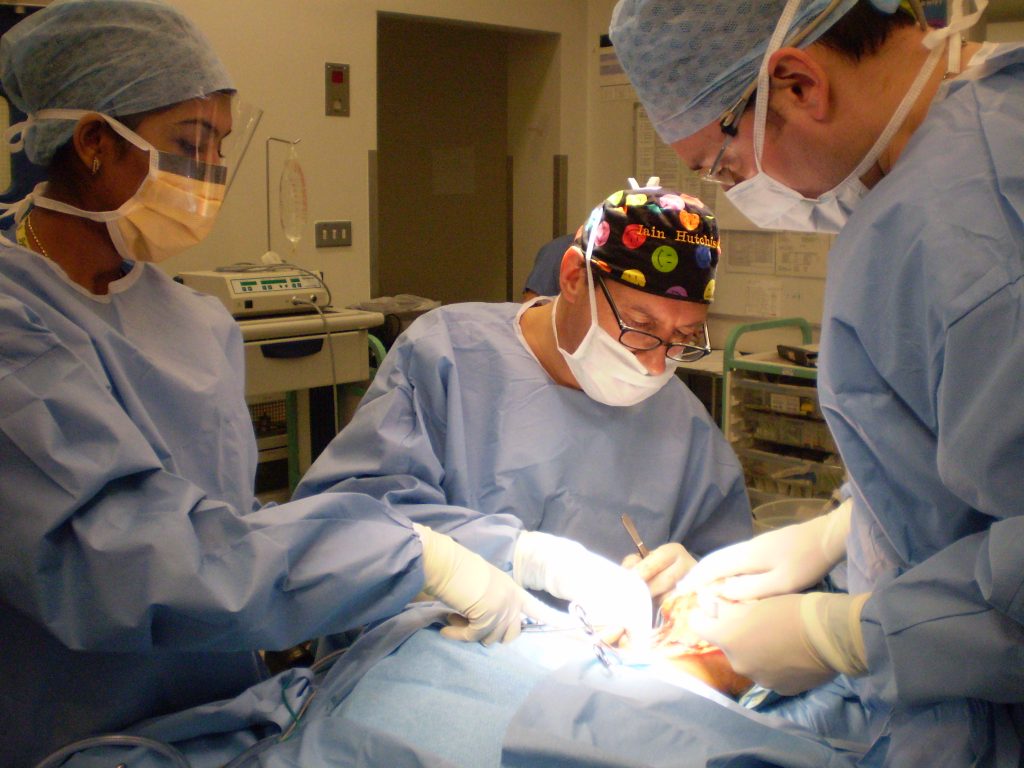Arthroscopy is a form of keyhole surgery in which a small telescope is inserted into a joint. This allows the inside of the joint to be examined in great detail. It can diagnose as well as treat problems within the jaw joint.
The skin tends to lose its elasticity with age. In the eyelids this results in excess skin which forms folds in the upper lids and deepening creases in the lower lids. There may also be a loosening of the muscles in the lower eyelid that allows fat from the eye socket to push forwards and produce bags. In some people there is an inherited tendency for eye bags to develop in early adult life before any skin changes. Rarely problems can develop in and around the eyes as a result of medical complaints (eg thyroid disease).
The disc of cartilage which lies in your jaw joint has moved out of its normal position between the bones.
An infection has occurred at the tip of the root of one of your teeth. Sometimes this does not cause any symptoms, but usually people are aware of discomfort and occasional episodes of swelling, gum boils or bad taste. You may well already have been given a course of antibiotics in an attempt to treat the infection.
This leaflet has been designed to improve your understanding of any forthcoming treatment and contains answers to many of the commonly asked questions. If you have any other questions that the leaflet does not answer or would like further explanation, please ask.
The problem
An infection has occurred at the tip of the root of one of your teeth. Sometimes this does not cause any symptoms but usually people are aware of discomfort and occasional episodes of swelling, gum boils or bad taste. You may well already have been given a course of antibiotics in an attempt to treat the infection.
Why do I need treatment?
If left untreated the infection is likely to develop into an abscess or cyst. As well as causing pain this can lead to the loss of bone surrounding the root. As a result the tooth will become loose.
What does treatment involve?
Your dentist will have already tried to get rid of the infection by removing the nerve of the tooth and placing a root filling. The infection now needs to be removed surgically in a procedure called an “apicectomy”. This involves cleaning out the infection from the bone, removing a small portion of the tip of the root of the tooth and then sealing the root with a small filling.
It is necessary to make a small cut in the gum over the root of the tooth and then lift the gum off the bone. The area of infection is uncovered by removing a small amount of bone with a drill. Any infected tissue is thoroughly cleaned away from the tip of the root before 2-3mm of the root tip are removed. The root is sealed with a small filling. The gum is then stitched back into place with dissolvable stitches that take around two weeks to disappear. The whole procedure will take around 30 minutes from start to finish.
What type of anaesthetic is used?
Usually an apicectomy is carried out under a local anaesthetic, ie an injection into the gum that numbs the area. This anaesthetic will prevent you feeling any pain during the procedure.
What can I expect after the operation?
When the local anaesthetic wears off a few hours after surgery there will be some discomfort. If it is likely to be very sore your surgeon will arrange pain killers for you. It might also be necessary to take a course of antibiotics. The discomfort is usually worse for the first few days although it may take a couple of weeks to completely disappear. You may require a day or two off work during which time you should avoid strenuous exercise.
Some swelling can occur both inside and outside the mouth after surgery. This is usually most noticeable for about two days. It is important to keep the site of surgery as clean as possible for the first few weeks after surgery. If it is difficult to use a toothbrush the area can be kept free of food debris by gently rinsing with a mouth wash or warm salt water (dissolve a teaspoon of kitchen salt in a cup of warm water) commencing on the day after surgery.
What are the possible problems?
It is unusual for the area to bleed after surgery, but should this happen it can usually be stopped by applying pressure over the area for at least 10 minutes with a rolled up handkerchief or swab. If the bleeding does not stop, please contact the department.
Lifting the gum to uncover the root of the tooth can occasionally lead to a numb feeling in the gum. This usually disappears after a few months. Because the gum is cut it can occasionally shrink back a few months after surgery as scar tissue forms. This is not normally a problem but if the tooth has been crowned the edge of the crown may become exposed.
Even if all the infection is successfully removed it can sometimes return months or even years later. If this happens it might be necessary to have the operation repeated but sometimes the tooth is better removed.
The Cyscope is a new technology that may well enable early detection of cancer cells without the need for a biopsy. We are currently developing automated diagnostic tools requiring limited specialist intervention, primarily for the detection of oral cancers, using a well-defined subset of cell features, employing pattern recognition and image analysis. Further studies continue to refine the categorising of cells into five subsets, graded from normal to cancerous, using a database of over 8000 images collected so far.
Update 17/10/2019: The results of the SEND study is published in the British Journal of Cancer and has been recommended in the F1000 Prime as being of special significance in its field.
Prof Iain Hutchison talks to Barbara Myers in a radio phone-in on oral health.
Reproduced from The Times. 25th February 2006.
Kelly Smith, 21, lives in Yorkshire. Aged 15, she had a rare form of cancer which necessitated the removal of one eye and some of the tissue around it.



